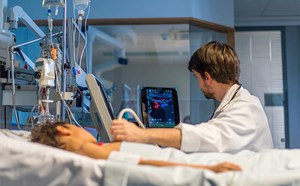
The Literature Canon Project: Behind the Curtains
Di Coneybeare, MD, MHPE - Columbia University Medical Center, Vagelos School of Physicians and Surgeons
Alexis Salerno, MD - University of Maryland, School of Medicine
Judy C. Lin, MD, FACEP - Texas Christian University, Burnett School of Medicine
How did we, a meager fellow education subcommittee, end up sifting through hundreds of papers every month? Well, let us tell you the story . . .
Once upon a time, the Emergency Ultrasound Section (EUS) of the American College of Emergency Physicians (ACEP) endowed the Fellow Education subcommittee with the mission to champion emergency ultrasound fellows’ education. What could be more paramount to fellow education than the core literature that support our subspecialty? We quickly found there existed no central repository of such treasure and set out to create one for ourselves. Thus, was borne the literature canon project.
In the beginning of the search, we started with the most foundational applications: the Focused Assessment with Sonography in Trauma (FAST), renal, and biliary. Our search began erratically without specific guidelines for subcommittee members. Our subcommittee members were nevertheless resourceful and scavenged high and low in the vast literature forest for all relevant papers. However, this made us wary of whether we may have missed important papers and therefore decided to perform a more rigorous search for future subjects. While we missed the mark for a systematic review, we aimed for adequacy. We found a systematic review of an ultrasound application within emergency medicine on a specific topic in a reputable journal and borrowed the structure of their search terms (Staub, Mazzali Biscaro, Kaszubowski, & Maurici, 2019). We then identified Medical Subject Headings (MeSH) terms for each interested organ system and inserted the MeSH terms into the search structure. You can find the search terms for our latest subjects in Appendix I.
After the initial search, we uploaded search results into Covidence systematic review software (Veritas Health Innovation, Melbourne, Australia). The papers were then first screened for relevance by Title only and then screened for importance for fellow education based on title and abstract by subcommittee members. For the 3rd screening, we contemplated modified Delphi methods, democracy, vote by council, and ultimately chose full text screening via a modified rubric based on established criteria set by our sister organization the Society for Academic Emergency Medicine (SAEM). You may peruse our rubric here. After each paper was scored by our subcommittee members, we formulated a cut-score of 19 out of 25 with the subcommittee based on the modified Angoff Method (Ben-David, 2000). You may find the citations for each category here.
As we continue to build the literature canon, we welcome any literature enthusiasts, especially fellows, to aid and assist in our endeavor. We welcome supporters and cynics alike to help improve the process and increase the validity of our product. Since the release of ChatGPT (yes the one whose alter-ego, Sydney, is in love with Kevin Roose, the New York Times Technology Columnist), we have been asking for its assistance. The lists are eerily and remarkably similar and then it kind of goes off the rails after ocular where it found articles on ankle fractures and nerve blocks in this category. Maybe that’s Sydney peeking through. And maybe humans are still needed after all. If you are interested in what ChatGPT has to say about core literature in emergency ultrasound, see appendix II.
References
Ben-David, M. (2000). AMEE Guide No. 18: Standard setting in student assessment. Medical Teacher - MED TEACH, 22, 120-130. doi:10.1080/01421590078526
Staub LJ, Mazzali Biscaro RR, Kaszubowski E, Maurici R. Lung ultrasound for the emergency diagnosis of pneumonia, acute heart failure, and exacerbations of chronic obstructive pulmonary sisease/asthma in adults: A systematic review and mMeta-analysis. J Emerg Med. 2019;56(1):53-69.
Appendix I: Search terms
Ocular:
("ultrasonics"[MeSH Terms] OR "ultrasonics"[All Fields] OR "ultrasonography"[Subheading] OR "ultrasonography"[All Fields] OR "ultrasound"[All Fields] OR "sonography"[All Fields]) AND ("eye"[MeSH Terms] OR "eye"[All Fields] OR "ocular"[All Fields] OR "orbit"[All Fields] OR “ophthalmic”[All Fields]) AND ("emergencies"[MeSH Terms] OR "emergencies"[All Fields] OR "emergency"[All Fields] OR "emergency service, hospital"[MeSH Terms] OR "intensive care"[All Fields] OR "critical care"[All Fields] OR "critical ill"[All Fields] OR "critical illness"[All Fields] OR “emergency medicine”[All Fields] OR “emergency department”[All Fields])
Deep Venous Thrombosis:
("ultrasonics"[MeSH Terms] OR "ultrasonics"[All Fields] OR "ultrasonography"[Subheading] OR "ultrasonography"[All Fields] OR "ultrasound"[All Fields] OR "sonography"[All Fields]) AND (“Phlebothrombosis”[MeSH Terms] OR “Phlebothrombosis”[All Fields] OR "Thrombosis, Venous"[MeSH Terms] OR "Thrombosis, Venous"[All Fields] OR "Deep Vein Thrombosis"[All Fields] OR "Deep Vein Thrombosis"[MeSH Terms] OR "Thromboses, Deep Vein"[All Fields] OR “Thromboses, Deep Vein”[MeSH Terms] OR "Vein Thrombosis, Deep"[All Fields] OR “Vein Thrombosis, Deep”[MeSH Terms] OR "Deep-Venous Thrombosis"[All Fields] OR “Deep-Venous Thrombosis”[MeSH Terms] OR “Deep-Vein Thrombosis”[All Fields] OR “Deep-Vein Thrombosis”[MeSH Terms]) AND ("emergencies"[MeSH Terms] OR "emergencies"[All Fields] OR "emergency"[All Fields] OR "emergency service, hospital"[MeSH Terms] OR "intensive care"[All Fields] OR "critical care"[All Fields] OR "critical ill"[All Fields] OR "critical illness"[All Fields] OR “emergency medicine”[All Fields] OR “emergency department”[All Fields] NOT COVID)
Testicular:
("ultrasonics"[MeSH Terms] OR "ultrasonics"[All Fields] OR "ultrasonography"[Subheading] OR "ultrasonography"[All Fields] OR "ultrasound"[All Fields] OR "sonography"[All Fields]) AND ("testicle"[MeSH Terms] OR "testicle"[All Fields] OR "testicular"[All Fields] OR "scrotum"[MeSH Terms] OR "scrotum"[All Fields] OR "scrotal"[All Fields] OR "male genital"[MeSH Terms] OR "male genital"[All Fields] OR "male genitalia"[All Fields]) AND ("emergencies"[MeSH Terms] OR "emergencies"[All Fields] OR "emergency"[All Fields] OR "emergency service, hospital"[MeSH Terms] OR "intensive care"[All Fields] OR "critical care"[All Fields] OR "critical ill"[All Fields] OR "critical illness"[All Fields] OR “emergency medicine”[All Fields] OR “emergency department”[All Fields] NOT COVID)
Aorta:
("ultrasonics"[MeSH Terms] OR "ultrasonics"[All Fields] OR "ultrasonography"[Subheading] OR "ultrasonography"[All Fields] OR "ultrasound"[All Fields] OR "sonography"[All Fields]) AND ("Aorta"[MeSH Terms] OR "Aorta"[All Fields] OR "Aorta, Thoracic"[MeSH Terms] OR "Aorta, Abdominal"[MeSH Terms] OR "Aortic Aneurysm"[All Fields] OR "Aortic Aneurysm"[MeSH Terms] OR "Aortic Diseases"[MeSH Terms] OR "Aortic Diseases"[All Fields]) OR “Mesenteric Ischemia”[MeSH Terms] OR “Aneurysm, Dissecting”[MeSH Terms] OR “Aortic Dissection”[All Fields]) AND ("emergencies"[MeSH Terms] OR "emergencies"[All Fields] OR "emergency"[All Fields] OR "emergency service, hospital"[MeSH Terms] OR "intensive care"[All Fields] OR "critical care"[All Fields] OR "critical ill"[All Fields] OR "critical illness"[All Fields] OR “emergency medicine”[All Fields] OR “emergency department”[All Fields])
Obstetrics part I-1st trimester pregnancies
("ultrasonics"[MeSH Terms] OR "ultrasonics"[All Fields] OR "ultrasonography"[Subheading] OR "ultrasonography"[All Fields] OR "ultrasound"[All Fields] OR "sonography"[All Fields]) AND ("First Pregnancy Trimester"[MeSH Terms] OR "First Pregnancy Trimester"[All Fields] OR "First Trimester"[MeSH Terms] OR "First Trimester"[All Fields]) AND ("emergencies"[MeSH Terms] OR "emergencies"[All Fields] OR "emergency"[All Fields] OR "emergency service, hospital"[MeSH Terms] OR "intensive care"[All Fields] OR "critical care"[All Fields] OR "critical ill"[All Fields] OR "critical illness"[All Fields] OR “emergency medicine”[All Fields] OR “emergency department”[All Fields] NOT COVID)
Appendix II:
We used the assistant of ChatGPT, a large language model trained by OpenAI, to identify key peer-reviewed journal articles that an emergency ultrasound fellow should read in the following subjects (ChatGPT. Personal Communications 2023).
EFAST:
The Extended Focused Assessment with Sonography for Trauma (EFAST) exam is an important tool used in the evaluation of trauma patients. Here are some peer-reviewed journal articles that could be helpful for emergency ultrasound fellows to read on this topic:
- Rozycki GS, Ochsner MG, Jaffin JH, et al. Prospective evaluation of surgeons' use of ultrasound in the evaluation of trauma patients. J Trauma. 1993;34(4):516-27.
- Boulanger BR, Kearney PA, Tsuei B, et al. The focused abdominal sonogram for trauma (FAST) examination: considerations and recommendations for training programs. J Trauma. 2003;54(5 Suppl):S110-S117.
- Scalea TM, Rodriguez A, Chiu WC, et al. Focused Assessment with Sonography for Trauma (FAST): results from an international consensus conference. J Trauma. 1999;46(3):466-72.
- Kirkpatrick AW, Sirois M, Laupland KB, et al. Hand-held thoracic sonography for detecting post-traumatic pneumothoraces: the extended focused assessment with sonography for trauma (EFAST). J Trauma. 2004;57(2):288-95.
- Rose JS, Bair AE, Mandavia D, et al. The UHP ultrasound protocol: a novel ultrasound approach to the empiric evaluation of the undifferentiated hypotensive patient. Am J Emerg Med. 2001;19(4):299-302.
- Ma OJ, Mateer JR, Ogata M, et al. Prospective analysis of a rapid trauma ultrasound examination performed by emergency physicians. J Trauma. 1995;38(6):879-85.
- Kimura A, Takenaka K, Yamamoto K, et al. The extended focused assessment with sonography for trauma (EFAST) protocol can detect major thoracic injury in the field. J Trauma. 2011;70(1):163-8.
These articles cover various aspects of the EFAST exam, including its history, indications, training programs, and utility in trauma evaluation. I hope you find them useful in your studies!
Renal:
Renal ultrasound is an important tool used in the evaluation of various renal pathologies. Here are some peer-reviewed journal articles that could be helpful for emergency ultrasound fellows to read on this topic:
- Lobo V, Lubner M, Menias C, et al. Renal ultrasound: the essentials. Radiol Clin North Am. 2017;55(2):217-33.
- Jang TB, Ruggeri W, Dyne P, et al. Renal ultrasound in the evaluation of acute kidney injury: developing a risk stratification framework for clinical use. Am J Emerg Med. 2014;32(7):775-8.
- Manthey D, Storrow A, Milbourn J, et al. Ultrasound versus computed tomography for establishing the diagnosis of acute pyelonephritis in adult ED patients: a prospective single-center study. Am J Emerg Med. 2015;33(5):659-63.
- Kim SH, Han MC, Kim HD, et al. Renal sonography in the evaluation of acute flank pain. AJR Am J Roentgenol. 1985;144(3):505-10.
- Heller MT, Harisinghani M, Neitlich JD. Renal imaging in the ED: sonography and CT. Emerg Med Clin North Am. 2004;22(3):659-77.
- Mojtahed A, Kajbafzadeh AM, Abdollahpour M, et al. Accuracy of bedside renal ultrasound in diagnosing hydronephrosis in children with acute abdominal pain. Am J Emerg Med. 2012;30(8):1627-31.
- Bude RO, DiPietro MA. Anatomic relationships of the renal hilum: a CT study. Radiology. 1992;184(1):33-9.
These articles cover various aspects of renal ultrasound, including its utility in acute kidney injury, acute flank pain, acute pyelonephritis, hydronephrosis, and anatomical relationships of the renal hilum. I hope you find them useful in your studies!
Biliary:
Biliary ultrasound is an important tool used in the evaluation of various biliary pathologies. Here are some peer-reviewed journal articles that could be helpful for emergency ultrasound fellows to read on this topic:
- Lee JY, Keane MG, Pereira SP. Diagnosis and assessment of suspected gallstone disease in the emergency department. Clin Radiol. 2014;69(4):373-81.
- Berland LL, Silverman SG, Gore RM, et al. Managing incidental findings on abdominal CT: white paper of the ACR incidental findings committee. J Am Coll Radiol. 2010;7(10):754-73.
- Shea JA, Berlin JA, Escarce JJ, et al. Revised estimates of diagnostic test sensitivity and specificity in suspected biliary tract disease. Arch Intern Med. 1994;154(22):2573-81.
- Toorenvliet BR, Wiersema AM, Hesselink EJ, et al. Routine computed tomography or ultrasound in the diagnostic work-up of biliary tract obstruction? Eur J Gastroenterol Hepatol. 2011;23(9):738-43.
- Lim SH, Kim do H, Lee SJ, et al. Ultrasonography for the diagnosis of acute appendicitis: experiences at a secondary emergency department. J Ultrasound Med. 2011;30(1):55-62.
- Havre RF, Eldevik OP, Gilja OH. Ultrasonography and magnetic resonance cholangiopancreatography for diagnosing common bile duct stones: a systematic review. Eur Radiol. 2008;18(3):337-46.
- Kimura Y, Takada T, Kawarada Y, et al. Definitions, pathophysiology, and epidemiology of acute cholangitis and cholecystitis: Tokyo Guidelines. J Hepatobiliary Pancreat Surg. 2007;14(1):15-26.
These articles cover various aspects of biliary ultrasound, including its utility in suspected gallstone disease, acute appendicitis, common bile duct stones, and acute cholangitis and cholecystitis. I hope you find them useful in your studies!
Ocular:
Ocular ultrasound is an important tool used in the evaluation of various ocular pathologies. Here are some peer-reviewed journal articles that could be helpful for emergency ultrasound fellows to read on this topic:
- Blaivas M, Theodoro D, Sierzenski PR. A study of bedside ocular ultrasonography in the emergency department. Acad Emerg Med. 2002;9(8):791-9.
- Shinar Z, Chan L, Orlinsky M. Use of ocular ultrasound for the evaluation of retinal detachment. J Emerg Med. 2012;42(5):573-6.
- Noble VE, Murray AF, Capp R, et al. Ultrasound assessment for extravascular lung water in patients undergoing hemodialysis. Time course for resolution. Chest. 2009;135(6):1433-9.
- Brown J, Rogers T, Sohoni A. Sonography in hypotension and cardiac arrest (SHoC): rates of detection of cardiac activity and outcomes of cardiac arrest patients. J Emerg Med. 2015;49(2):270-7.
- Dhungana S, Shrestha GS. Accuracy of point-of-care ocular ultrasound for the diagnosis of retinal detachment: a systematic review and meta-analysis. J Clin Ultrasound. 2021;49(1):27-34.
- Yoonessi R, Hussain A, Jang TB. Bedside ocular ultrasound for the detection of retinal detachment in the emergency department. Acad Emerg Med. 2010;17(9):913-7.
- Blaivas M, Adhikari S, Lander L. A prospective comparison of procedural sedation and ultrasound-guided nerve block for ED treatment of ankle fractures. Am J Emerg Med. 2011;29(6):643-9.
These articles cover various aspects of ocular ultrasound, including its utility in the evaluation of retinal detachment, cardiac activity, extravascular lung water, and ankle fractures. I hope you find them useful in your studies!
DVT:
Ultrasound evaluation of lower extremity deep venous thrombosis (DVT) is a common indication for emergency ultrasound. Here are some peer-reviewed journal articles that could be helpful for emergency ultrasound fellows to read on this topic:
- Kearon C, Ginsberg JS, Douketis J, et al. An evaluation of D-dimer in the diagnosis of pulmonary embolism: a randomized trial. Ann Intern Med. 2006;144(11):812-21.
- Righini M, Van Es J, Den Exter PL, et al. Age-adjusted D-dimer cutoff levels to rule out pulmonary embolism: the ADJUST-PE study. JAMA. 2014;311(11):1117-24.
- Wells PS, Anderson DR, Rodger M, et al. Evaluation of D-dimer in the diagnosis of suspected deep-vein thrombosis. N Engl J Med. 2003;349(13):1227-35.
- Beyer-Westendorf J, Schellong SM. How I treat superficial vein thrombosis. Blood. 2019;133(9):729-36.
- Vlahos A, Feinstein M, Lyon M. Ultrasound in the diagnosis and management of venous thromboembolism. J Clin Imaging Sci. 2013;3:48.
- Bates SM, Jaeschke R, Stevens SM, et al. Diagnosis of DVT: antithrombotic therapy and prevention of thrombosis, 9th ed: American College of Chest Physicians Evidence-Based Clinical Practice Guidelines. Chest. 2012;141(2 suppl):e351S-e418S.
These articles cover various aspects of ultrasound evaluation for DVT, including the use of D-dimer in diagnosis, age-adjusted D-dimer cutoffs, and the management of superficial vein thrombosis. I hope you find them useful in your studies!
Testicular:
Testicular ultrasound is an important tool in the evaluation of acute scrotal pain and swelling. Here are some peer-reviewed journal articles that could be helpful for emergency ultrasound fellows to read on this topic:
- Dogra VS, Gottlieb RH, Oka M, Rubens DJ. Sonography of the scrotum. Radiology. 2003;227(1):18-36.
- Sidhu PS, Cantisani V, Deganello A, et al. Role of ultrasound in the assessment of male infertility. Radiology. 2012;262(2):340-56.
- Patel RP, Zaheer S, Srinivasan J, et al. US of the male genital tract. Radiographics. 2018;38(6):1591-1614.
- Stein DM, Thum DJ, Barbagli G, et al. AUA guidelines: diagnosis and treatment of non-neurogenic male lower urinary tract symptoms including benign prostatic obstruction. J Urol. 2018;200(3):612-9.
- Kim SH, Kim HD, Lee HJ, Lee SE. The efficacy of testicular ultrasound in differentiating torsion from epididymo-orchitis. Korean J Urol. 2010;51(10):689-93.
These articles cover various aspects of testicular ultrasound, including the sonographic evaluation of the scrotum, the role of ultrasound in male infertility, and the differentiation of torsion from epididymo-orchitis. I hope you find them useful in your studies!
Aorta:
Aorta ultrasound is a critical diagnostic tool for assessing patients with suspected aortic pathologies, such as aneurysms and dissections. Here are some peer-reviewed journal articles that emergency ultrasound fellows should consider reading on this topic:
- American College of Emergency Physicians. Emergency ultrasound guidelines. Ann Emerg Med. 2009;53(4):550-70.
- Moore CL, Molina AA, Lin H. Ultrasonography in community emergency departments in the United States: access to ultrasonography performed by consultants and status of emergency physician-performed ultrasonography. Ann Emerg Med. 2006;47(2):147-53.
- Nazerian P, Vanni S, Castelli M, et al. Accuracy of point-of-care ultrasound for diagnosis of thoracoabdominal injuries in blunt trauma. World J Emerg Surg. 2016;11:49.
- Scali S, McGuire J,Ferencik M, et al. Point-of-care ultrasound is a sensitive diagnostic tool for detecting thoracic aortic injuries following blunt chest trauma: a prospective observational study. Eur J Trauma Emerg Surg. 2017;43(5):687-95.
- Tulsyan N, Kashyap VS, Greenberg RK, et al. The endovascular management of visceral artery aneurysms and pseudoaneurysms. J Vasc Surg. 2007;45(2):276-83.
These articles cover various aspects of aorta ultrasound, including the use of ultrasound in emergency medicine, the accuracy of point-of-care ultrasound in detecting thoracoabdominal injuries, and the endovascular management of aortic aneurysms and pseudoaneurysms. I hope these articles help you in your studies!
Obstetrics/gynecology Part I: 1st trimester
Emergency ultrasound in the first trimester of pregnancy is an important tool for evaluating patients with symptoms such as vaginal bleeding or abdominal pain. Here are some peer-reviewed journal articles that emergency ultrasound fellows should consider reading on this topic:
- American College of Emergency Physicians. Emergency ultrasound guidelines. Ann Emerg Med. 2009;53(4):550-70.
- Anderson KL, Fields JM, Panebianco NL, et al. Inter-rater reliability of pelvic ultrasound identification of intrauterine pregnancy in patients with a pregnancy of unknown location. J Emerg Med. 2013;44(3):583-7.
- Brown J, Hebert K, Boysen DA, et al. Use of ultrasound in the trauma setting. J Trauma Nurs. 2008;15(4):176-82.
- Dubin JS, Wells M, Benson CB, et al. Prospective evaluation of emergency department bedside ultrasonography for the detection of acute cholecystitis. Ann Emerg Med. 1999;34(4 Pt 1):438-42.
- Kirkpatrick AW, Sirois M, Laupland KB, et al. Hand-held thoracic sonography for detecting post-traumatic pneumothoraces: the extended focused assessment with sonography for trauma (EFAST). J Trauma. 2004;57(2):288-95.
These articles cover various aspects of emergency ultrasound in the first trimester of pregnancy, including the use of ultrasound in emergency medicine, the inter-rater reliability of pelvic ultrasound for identifying intrauterine pregnancy, and the utility of bedside ultrasound for detecting acute cholecystitis. I hope these articles help you in your studies!



